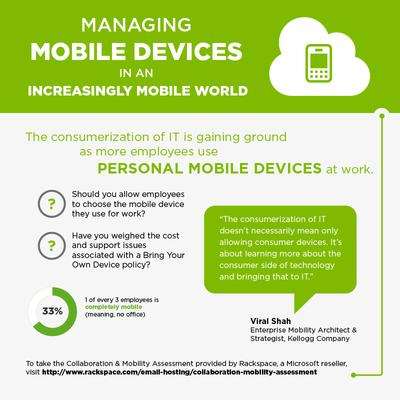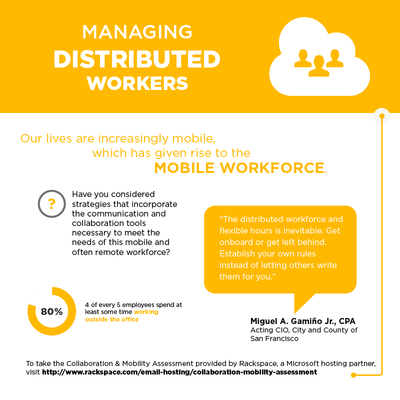Employees are demanding faster, uninterrupted access to data; and the freedom to work anywhere, anytime, at the device of their choosing. While it is vital that employees gather to collaborate, the work world and employee expectations are changing and evolving more rapidly than ever. The future of work will require new styles of information technology to support a distributed workforce of mobile millennials.
These changes raise some questions related to a company's mobile readiness: Should your company adopt a Bring Your Own Device (BYOD) or Mobile Device Management (MDM) policy? Does your company have the right collaborative culture, a factor I discussed in Telecommuting Policies Revisited? While Yahoo and Facebook have answered these questions by establishing in-house work policies, each enterprise has to devise a mobile strategy that best fits its culture and business goals.
Ryan Neading is the Chief Information Officer (CIO) of Rackspace. Rackspace uses a Collaboration & Mobility Assessment tool to help businesses determine their mobile strategy and readiness. The tool was developed with Miguel A. Gamiño Jr., CIO of the City and County of San Francisco, Deborah Mills-Scofield, partner at Glengarry, LLC, and Viral Shah, enterprise mobility architect at Kellogg Company, and provides tips and insights from industry experts. When a business has a clearer view on how to support its mobile employees, it can more easily gain the benefits of a dispersed workforce, such as decreased travel costs, improved communications and IT administration, and maximized productivity. Yet navigating mobility issues and the subsequent effects on teamwork can challenge any industry.Here are the four common challenges of the dispersed workforce.
1. The consumerization of IT and its impact on the business
It is no longer assured that businesses provide every worker with the very fastest and most sophisticated devices. Employees are increasingly using personal technology including smartphones and tablets not only in the office, but also when working at home or in the local coffee shop. This consumerization of IT, the catalyst responsible for pushing many businesses to implement an MDM strategy, does not spell the end of IT as a vital function within a company. Why not? Because there is more to providing a secure and manageable IT environment than just an MDM strategy.
Consumerization opens up a broad IT can of worms. According to Viral Shah, "The consumerization of IT goes well beyond just dealing with consumer devices. It involves learning more about the consumer side of technology and bringing that to IT." Although you might expect additional costs from security and underlying compliance requirements, Shah has found this barrier is nonexistent. Mobile banking is a good example. "Banks have more compliance and security concerns than most industries," asserts Shah. "If they can figure out how to allow their users access to sensitive financial data over the public Internet, how long can your IT justify old, overly-restrictive rules?" 
2. Employees who establish their own BYOD practiceIt will not surprise anyone to read that interest in employees using personal mobile devices at work has risen drastically over the last few years. Although the inclination of many IT leaders was initially to resist this movement, accommodating the devices has now become the norm for the following reasons:
- Security: Many employees had worked around IT, putting business data at risk. Ignoring the problem was not solving anything and only led to greater security vulnerabilities.
- Better remote management tools: In addition to being able to wipe remote devices in case of loss or theft, encrypting storage and adding SSL encryption to data in transit are recommended steps to safeguard data.
- Freedom of choice: Allowing people to use their own devices has been shown to increase employee morale and retention. More and more companies are offering BYOD strategies, and if you do not, your business will be a less desirable place to work.
What should you do when employees are using devices that may not be password-protected or apps that are not sanctioned by IT? According to research from Forrester's David Johnson, "Once you learn that BYOD is happening in your organization, you have a legal obligation to do something about it, whether you have established industry guidance to draw on or not." The bottom line is that you cannot take a one-size-fits-all approach to establishing your guidelines.
Using an ethical firewall (with a tool like Lync, for example) enables an organization to control the information exchange per security and compliance requirements of HIPAA or PCI. Other guidelines to consider are the frequency of data backups, password requirements, and clarity regarding who is responsible for device maintenance.
3. The hidden costs of enterprise mobility The cost of upgrading mobile applications and whether administrators have to physically update each device are just two considerations warranting your attention. Additionally, you'll want to consider:
- Subscriptions for required monthly services: Ensuring that employees have access only to those services they truly need will help you manage costs.
- Training: You must consider training for existing employees, as well as new employees down the line. Will you offer in-person sessions or provide self-guided tutorials?
- Ongoing support: Your IT support staff may need to provide troubleshooting and advice for a wide range of devices and operating systems. Will that require additional training or hiring of new staff with these skills?
- Project rollout: This can become more expensive if it has to be started and stopped to accommodate all departments, rather than implemented in a smooth, continuous roll-out.
4. Fostering collaboration among a dispersed workforceWhen it comes to telecommuters and mobile employees, it is natural to be worried about low productivity and hindrances to collaboration. A study by University of Illinois business professor Ravi S. Gajendran brings some good news to this issue, showing that "telecommuting yields positive effects for two important measures of employee performance: work performance and loyalty to the company." Done right, allowing employees to work remotely can be a boon to both you and your employees.
Managing a dispersed workforce does necessitate setting some parameters, such as maintaining a schedule for weekly check-ins and providing access to professional space that can be used for client meetings. You will also want to consider implementing digital collaboration toolsets. Providing integrated tools does not bring a dispersed team geographically closer or make them magically more productive, but it can give the team a more connected feel. When employees sign on to Lync, for example, and see other colleagues are also signed on, everyone knows the team is working and available for collaboration as needed.
Having the right tools in place is important, but as management consultant Deb Mills-Scofield cautions, you don't want the tools getting in the way. "Watch how your people interact and work and how they collaborate," she advises, and from there, choose the tools that can help you build collaborative teams that work more efficiently over time. 
Mobility has changed the way we work and its impact continues to unfold. The Collaboration & Mobility Assessment can be your guide to determining your business's mobile readiness and help you achieve seamless collaboration initiatives. Whether managing telecommuters, business travelers, or freelancers, tackling mobility challenges head on will help you manage your dispersed workforce in a way that makes sense for your business and your employees.
This post was co-authored with Ryan Neading, Chief Information Officer of Rackspace, Inc.


